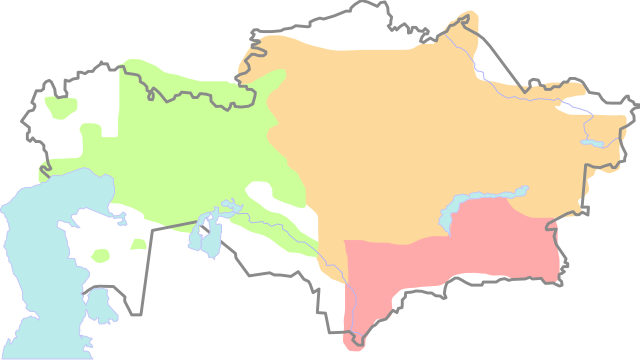Loading AI tools
One of the three territorial/tribal divisions in modern Kazakhstan From Wikipedia, the free encyclopedia
A jüz (/ˈ(d)ʒ(j)uːz/; Kazakh: ٴجۇز / жүз, pronounced [ʒʉz], also translated as 'horde') is one of the three main territorial and tribal divisions in the Kypchak Plain area that covers much of the contemporary Kazakhstan. It represents the main tribal division within the ethnic group of the Kazakhs.
This article needs additional citations for verification. (June 2015) |

This section contains weasel words: vague phrasing that often accompanies biased or unverifiable information. (July 2024) |
The earliest mention of the Kazakh jüz or hordes dates to the 17th century. Velyaminov Zernov (1919) believed that the division arose as a result of the capture of the important cities of Tashkent, Yasi, and Sayram in 1598.[1]
Some researchers argued that the jüz in origin corresponded to tribal, military alliances of steppe nomads that emerged around the mid 16th century after the disintegration of the Kazakh Khanate. They played a role in regulating livestock, access to watering holes, pastures, and the sites of nomadic camps.[2]
Yuri Zuev[year needed] argued their territorial division comprises three ecological or topographic zones, the Senior jüz of the southern and southeastern steppe being set apart from the two other zones by Lake Balkhash.
According to some researchers, the Kazakhs were separated in the First Civil War. Tribes that recognized Buidash Khan formed the Senior jüz. Tribes that recognized Togym Khan formed the Middle jüz. Tribes that recognized Ahmed Khan formed the Junior jüz.
According to Kazakh legends,[citation needed] the three jüz were the territorial inheritances of the three sons of the legendary founder-ancestor of the Kazakhs. The word jüz (жүз) also means "a hundred" in Kazakh.

Historically, the Senior jüz (Kazakh: Ұлы жүз, romanized: Ūly jüz, ۇلى ٴجۇز) inhabited the northern lands of the former Chagatai Ulus of the Mongol Empire, in the Ili River and Chu River basins, in today's South-Eastern Kazakhstan and China's Ili Kazakh Autonomous Prefecture (northern Xinjiang). It was also called Üisın jüz.
The first record of the Senior jüz dates to 1748, due to a Tatar emissary of the Tsaritsa who had been sent to the steppe to negotiate the submission of Abul Khair Khan in 1732. According to Nikolai Aristov,[citation needed] the estimated population of the Senior jüz was about 550,000 people in the second half of the 19th century. The territory was conquered by the Kokand Khanate in the 1820s, and by the Russian Empire during the 1850s to 1860s.
Kazakhstan's ruling elite, including former president Nursultan Nazarbayev, former First Secretary of the Communist Party of Kazakhstan Dinmukhamed Konayev, as well as famous poet Jambyl Jabayev are representatives of the Senior jüz.
There have been several attempts to determine the exact names and nature of top-level clans throughout the 19th and early 20th centuries. However, different studies created vastly different names and population numbers for the steppe clans. Generally accepted names of the first order Senior jüz tribes or clans are:[citation needed]

The Middle jüz (Kazakh: Орта Жүз, romanized: Orta Jüz, ورتا ٴجۇز, also known as Arğyn Jüz [Арғын Жүз]), occupies the eastern lands of the former Golden Horde, in central, northern and eastern Kazakhstan.
Some of Kazakhstan's famous poets and intellectuals were born in the Middle jüz territories, including Abay Qunanbayuli, Akhmet Baytursinuli, Shokan Walikhanuli and Alikhan Bokeikhanov.
The Middle jüz consists of the following tribes:
The Junior or Lesser jüz (Kazakh: Кіші Жүз, romanized: Kışı Jüz, كىشى ٴجۇز, also known as Alşyn Jüz) occupied the lands of the former Nogai Khanate in Western Kazakhstan.
They originate from the Nogais of the Nogai Horde, which once was placed in Western Kazakhstan, but in the 16th century it was defeated by the Kazakhs and the Russians and Nogais retreated to the Western part of their khanate, to the Kuban River steppes. In the 18th century, they endangered inner Russian cities, so the Russian Empire allied with the Mongolic Kalmyks to supplant the Alshyns and push them back to the Urals. There they formed the Lesser jüz. During the Kazakh-Kalmyk struggles, the Khiva Khanate annexed the Mangyshlak Peninsula to repel Kalmyk raids and managed it for two centuries before the Russian conquest. At the beginning of the 19th century, Kazakhs shifted some to the west, to Astrakhan Governorate, forming Bukey Horde there. When the Kazakh SSR was formed. Bukey Horde was positioned in its most remote, western part,[clarification needed] situated geographically in Europe.
Historical leaders of Kazakh resistance against the Russian Empire associated with the Junior jüz include Isatay Taymanuly (Kazakh: Isatai Taimanūly, 1791–1838) and Makhambet Otemisuly (Kazakh: Mahambet Ötemısūly, 1803/4–1846).
The Junior jüz consisted of three groups, subdivided into clans:
Various supposed fourth jüzes typically encompass members of other ethnic groups living in Kazakhstan, in particular Koreans and Russians. This has been argued to create more national unity.[4][5][6]
In jüzes, a clear purpose of each son in the family is determined. According to the customs and traditions of the Kazakhs, different people were engaged in the upbringing of each son.
To this day, knowledge of one's genealogical tree, including one's jüz, is considered a duty of every Kazakh.[7] Any relative who comes for help (even the most distant one) will definitely receive it.
Seamless Wikipedia browsing. On steroids.
Every time you click a link to Wikipedia, Wiktionary or Wikiquote in your browser's search results, it will show the modern Wikiwand interface.
Wikiwand extension is a five stars, simple, with minimum permission required to keep your browsing private, safe and transparent.